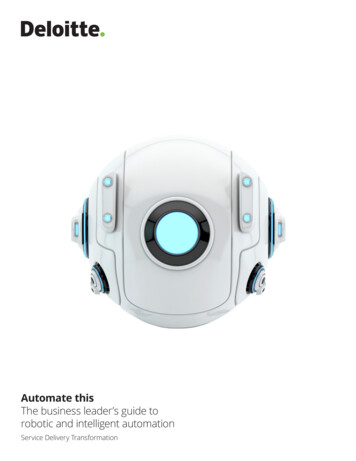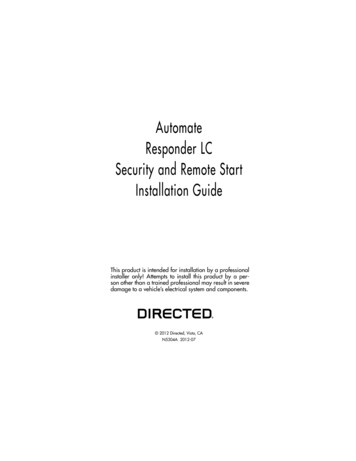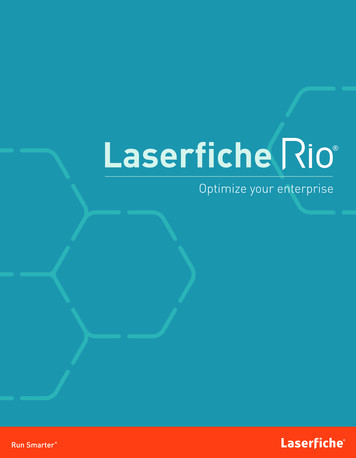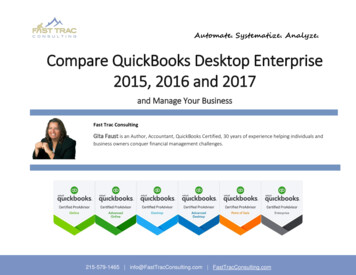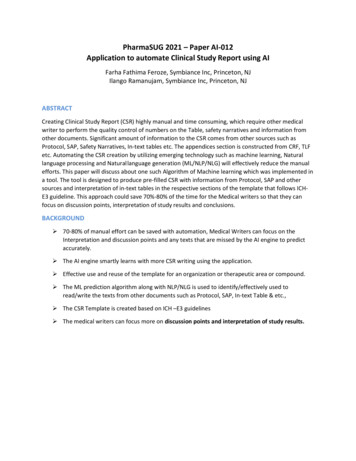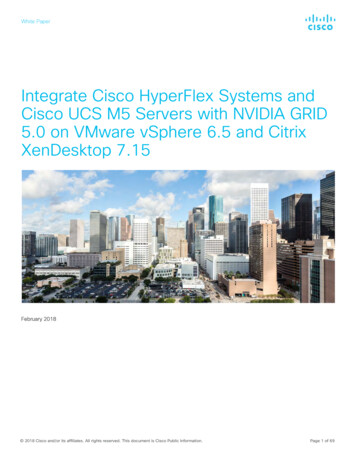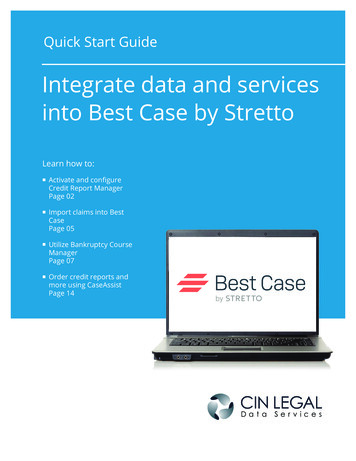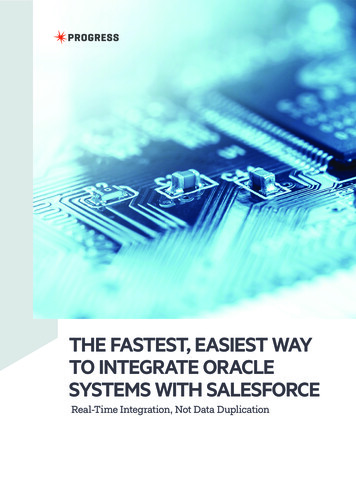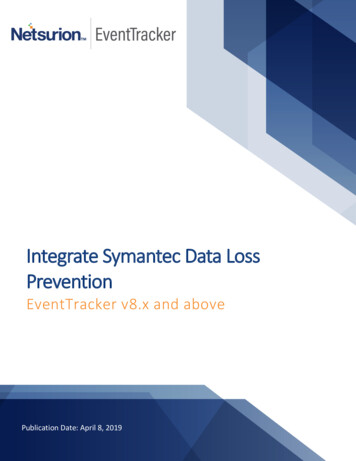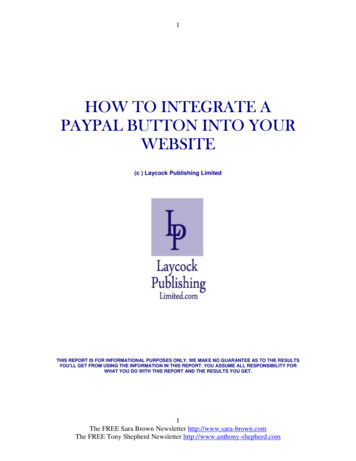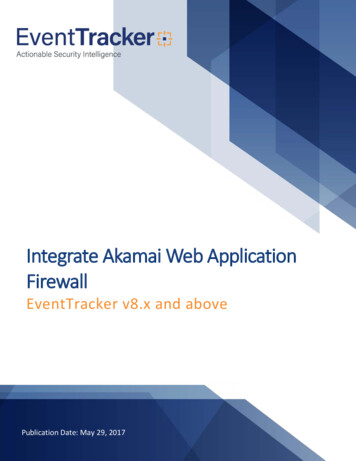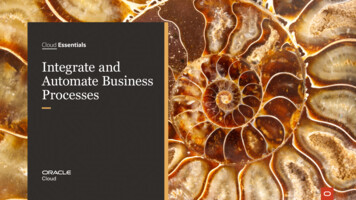
Transcription
Cloud EssentialsIntegrate andAutomate BusinessProcesses
As business operations move to the cloud, making themost of modern IT environments often involves figuringout how to connect on-premise applications with cloudapps and services, including applications for ERP, customerexperience (CX), human capital management (HCM), andmany others. Integration has become a fundamental partof today’s digital business development— connecting newsystems with old and extending your reach to drive newrevenue streams. Fortunately, intelligent automation andintegration are much easier and faster in the cloud era.Previously, developers had to figure out how to map databetween applications, and they weren’t always familiar withthe specific message structures and data models involved.Software-as-a-service (SaaS) applications typically hadrudimentary utilities for sharing data, and few hadout-of-the-box connectors for linking applications.Today, Oracle Integration makes it easy to connect your applications and automate end-to-endprocesses such as procure to pay, inquiry to order, and hire to retire. Anyone familiar with theapplications can do drag-and-drop integration without coding. Robotic Process Automation(RPA) and data-mapping recommendations power engaging experiences by providing bestnext steps using AI and machine learning (ML). And because Oracle manages the environment,you don’t have to deal with provisioning hardware, installing software, and keeping theenvironment current.SalesSCMHCMServiceCPQE-Business SuiteERPMarketingJD EdwardsPeopleSoft
A Better Way to Connect:Oracle IntegrationOracle Integration offers innovative methods foraccelerating all types of application connection andprocess automation projects. They include out-of-thebox templates and adapters to connect virtually anydata store, process, application, service, or API acrossmodern and legacy sales, marketing, HCM, finance, andorder-management systems. These prebuilt applicationadapters, recipes, and process templates simplify dataconnections, enrichment, monitoring, and performance.They give your applications IT team a point-and-clickenvironment to easily integrate cloud and on-premiseapplications such as Oracle Enterprise Resource Planning,Oracle Enterprise Performance Management Cloud,Oracle Supply Chain Management Cloud, Oracle NetSuite,Oracle Engagement Cloud, Oracle Marketing Cloud,Oracle Commerce Cloud, Oracle E-Business Suite, OracleSiebel, Oracle PeopleSoft, Oracle JD Edwards— and manynon-Oracle applications, including Salesforce, Workday,ServiceNow, and SAP.You can use these integration assets without having tounderstand the underlying technical details. For example,a prebuilt integration flow might synchronize activitiesbetween Oracle Service Cloud and Oracle Configure, Price,and Quote Cloud so that field-service personnel haveinstantaneous visibility into orders for replacement parts.Another integration might link Salesforce with ServiceNowto ensure that sales reps are informed whenever acustomer has an issue or makes a special request. Theseprebuilt assets can jump-start your move to the cloud. Speed up innovation with a point-and-clickvisual designerIntegrate all types of applications, databases,and business processes Maximize the value of investments in SaaS applications Monitor transactions through an interactive dashboard Utilize prebuilt integrations and process flows Oversee the exchange of data and theexecution of transactionsAnd now that you have connected your businessapplications, included with Oracle Integration is Oracle VisualBuilder, which enables you to rapidly and easily create anddeploy engaging web and mobile apps with minimal codingusing a visual browser-based development environment.Oracle Integration includes prebuilt integrations through Oracle Cloud Marketplace,with database, application, social, and productivity adapters that let you easily connect anything.For a complete list of application adapters, see ication-adapters/Large Prebuilt Adapter LibraryMarketoOracleCPQ CloudOracleService CloudOracleERP CloudOracleResponsysTwilioAdobe MySQLIBMDB2FTPservicesSAP R/3SOAPservicesSAPConcurRESTservicesOracleField ServiceOracle aMessagingServiceOracleJD acebookOracleMicrosoft SQLE-Business Suite ServerOracle ogle Calendar GmailOracleSiebelTrelloOracleEnterpriseCommerce CloudMessagingservicesOracleEloqua CloudOracleUtilitiesDocuSignServiceNowOracle Database
Integration for BusinessFrom agile finance to purchasing to human resourcesto supply chain planning, Oracle Integration helps yourapplications IT team quickly automate routine businessprocesses and connect workflows to streamline essentialactivities. Oracle API Platform Cloud Service lets yourapplication developers better manage the creation,consumption, and monetization of APIs.Let’s look at a few examples.Customer experience management.Human capital management.If a customer opens a ticket with your customer supportorganization, that issue should be documented not only inyour customer service app but in your sales app as well, sothat salespeople are aware of all open service issues withinthat account. You may have an on-premise CRM systemand a cloud-based salesforce automation system. You needintegration technology to connect these apps and keep yoursales organization, service organization, and other partsof the enterprise in sync. Oracle Integration can make thenecessary connections, and it works behind the scenes toenable seamless business flows. Conversational interactionsdemand flawless back-office execution, and that’s whereintelligent process automation comes in. Robotic ProcessAutomation (RPA) handles the mundane tasks involvinglegacy mainframe or AS400 applications for memberrenewals at healthcare, financial services, and energyfirms. This reduces cost and risk while improvingcustomer experiences and renewal rates.Oracle Integration can also help you unify on-premise HRISand modern cloud-based HCM systems. For example, youmight migrate some of your HCM talent and procurementapplications to the cloud while maintaining employee dataon premise. Cloud-based integrations can simplify theseconnections so you can streamline recruiting activities,integrate new payroll processes with your existing generalledger, and make it easier for employees to manage theirvacation, healthcare choices, and 401(k) investments via amobile self-service app. Talent management from inquiryto exit involves complex and sensitive content and approvalsacross the full lifecycle. Intelligent process automationsimplifies the complex web of policies and business rulesto accelerate time to productivity and build engagement.
Enterprise Resource PlanningOracle Integration can integrate and automate businessprocesses across virtually any module of any ERPapplication. Digital app and interface developers can drawfrom a library of prebuilt templates and ERP applicationadapters for Oracle E-Business Suite, JD Edwards, SAP,and more to rapidly connect applications and functions.These adapters mask the underlying complexities andsort out differences among the various protocols requiredby each application vendor. This is especially valuable forimproving slow cross-departmental approval and exceptionmanagement processes. Consider an order-entry processthat requires so many approvals it leads to delays in fulfillingorders for customers. You can visually design and deliverautomated processes using prebuilt QuickStart templatesto speed up this workflow and streamline the underlyingconnections, improving visibility into orders and forgingreal-time links among applications handling sales, pricequotes, logistics, and other key functions.Oracle Integration. Simplify integration Integrate anywhere: cloud, on premise, or hybrid Connect process automation with application integration Visualize analytics spanning multiple applications Unify API design, management, and security
The Oracle Edge: A Complete Integration SolutionOracle leverages many years of SaaS and on-premise application expertise to deliver industry-leading application integration,process automation, data integration, digital assistants, analytics, and many other innovations. While Oracle Integrationmakes it easy to connect applications, data stores, and information systems, Oracle’s cloud-based data visualization andbusiness intelligence services help managers discover and share strategic insights.All in the family.Process automation: Automate workflowsacross departments.API management: Enjoy complete lifecyclemanagement through an API portal.Visual application builder: Simple weband mobile app creation for everyone.Business insight: Visualize end-to-endprocess status across applications. Rapidly build end-to-end workflows byselecting from Oracle’s QuickStart library Visually define rules and forms formobile approvals that span departmentsCreate web, mobile, and progressiveweb apps (PWA) in minutes from yourbrowser with single-button publishing Simplify API development whileimproving the performance andsecurity of your application servicesGain real time visibility intodigital processes to help focusinnovation efforts Analyze work streams in real timeto optimize operationsWhat you see is what you get—leveragevisual designers to build your application Create, manage, and exchange APIsamong developers and third parties Enable unified experiences by pullingdata from multiple applications Access a prepopulated Oracle SaaScatalog and any other REST services,or leverage the power of prebuiltOracle Integration connectorsto connect to any applicationDrag and drop key businessmilestones to coordinate activitiesin context of SLAs Increase business responsivenesswith early warnings and actionableintelligence
Application integration: Accelerate SaaSand on-premise connections. Quickly integrate Oracle, non-Oracle, andcustom applications with visual designers Leverage technical best practices with prebuilt,supported adapters and recipes Simplify data mapping between low-leveltechnical APIs with ML recommendationsFollow the leader.Gartner named Oracle a leader for the thirdyear in its 2019 Magic Quadrant for EnterpriseIntegration Platform as a Service.Oracle Application IntegrationDigital ityAugmented onAdaptersCloud to tizeCloud to GroundVisual AppBuilderGround to GroundSecurityBusiness Insight
The organization.The success.Calix is a provider of broadband communicationsaccess systems and software.Now, service providers can purchase equipment with little orno intervention from Calix sales personnel. Oracle Integrationmanages the exchange of data between Oracle CommerceCloud and Oracle CPQ Cloud as customers configure, price, andquote their orders via a nimble self-service environment. OracleIntegration references CRM data from Salesforce, and logs ordersin the Oracle E-Business Suite system as part of a completequote-to-order process.The challenge.Calix wanted to create a self-service, ecommerce environmentthat would allow telecommunication companies and other serviceproviders to easily order routers, switches, and other communicationsequipment online. With Calix’s previous ecommerce environment,it took 20 to 30 minutes to produce a quote, and Calix’s busysales team often had to intervene to verify accuracy. They neededtighter integration among Oracle CPQ Cloud, Salesforce, and OracleE-Business Suite to streamline these processes.Calix also saw a significant reduction in employee onboardingprocesses, including a 90 percent decrease in time to provisionnew employees.The strategy.Calix used Oracle Integration to speed up this workflow and simplifythese B2B connections. It leveraged prebuilt adapters in OracleIntegration to quickly connect Salesforce, Oracle E-Business Suite,Oracle Commerce Cloud, and Oracle CPQ Cloud in just a few hours(compared with) weeks for similar development projects in the past.It also consolidated the interfaces created by Informatica and twoother third-party integration tools into a single, unified platformfor their digital business. It used Oracle Integration to streamlineand automate manual processes for employee onboarding andsystem provisioning.“The prebuilt adapters in Oracle Integrationallowed us to create new interfaces in justa few hours, versus the weeks similar projectsrequired in the past.”Doug Berringer, Business Solutions Architect, Calix
Oracle Cloud InfrastructureCloud EssentialsOracle Integration is built on Oracle Cloud Infrastructure (OCI),which has reimagined the cloud for the most important enterpriseapplications and infrastructures.Optimized for Oracle: It’s optimized for Oracle apps and databasesand provides the foundation for Oracle Autonomous Database.Extreme performance: OCI meets or exceedsthe performance of on-premise data centers.Learn more about Oracle Integration atoracle.com/integration or try our fun andinformative Avatar-led Oracle Integrationdemonstration now.Your choice: It provides the versatility to run traditionaland cloud native workloads on the same platform.Lower cost: It offers predictable savings through simple,competitive, and flexible pricing.More secure: With OCI, you can migrate and/or runOracle’s databases, business applications, and infrastructureportfolio with unmatched security and scalability.Copyright 2020, Oracle and/or its affiliates. All rights reserved. This document is provided for informationpurposes only, and the contents hereof are subject to change without notice. This document is not warrantedto be error-free, nor subject to a
As business operations move to the cloud, making the . most of modern IT environments often involves figuring . out how to connect on-premise applications with cloud apps and services, including applications for ERP, customer experience (CX), human capital management (HCM), and many others. Integration has become a fundamental part of today’s digital business development— connecting new .
